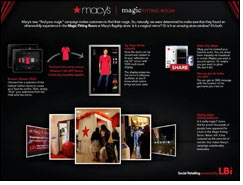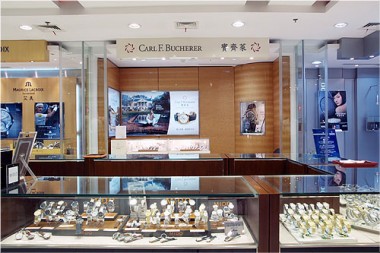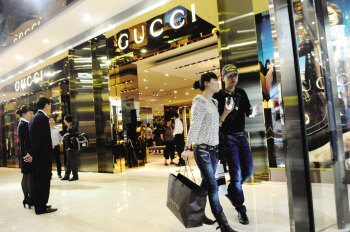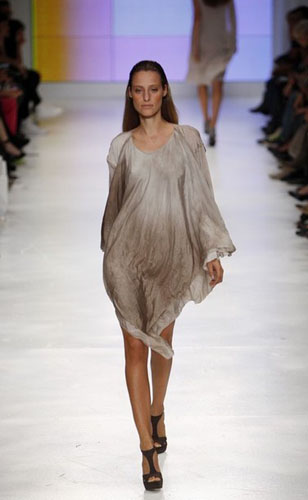 Anna Le
Anna Le Nhi Py
Nhi Py Theo Ortengren
Theo Ortengren Kellen Hofer
Kellen Hofer Marie M
Marie M
Textiles, Pakistan's leading export industry is saving high hopes on the negotiations going on between Pakistan and European Union for gaining free market access in EU, which if it turns positive, would greatly enhance the core export industry of the country.
Experts are expecting the talks to turn positive, on the assumption that the EU market may grant the access in view of the massive floods in Pakistan which have ravaged a greater part of the country. Also as the floods have devastated the country's economy, there is an intensified need for striking this deal with EU, at the earliest.
Presently, whereas the 27-country strong EU, is deliberating on the ways to provide assistance to Pakistani exports to EU, the textile sector experts in Pakistan stated that, there are three main issues that need to be decided.
First being the list of the items, next, the extent of duty concession and the last one being the period for which these duty concessions should be granted. EU is likely to disclose its tariff concession plan, soon.
As of now, 24 percent of country's overall exports which comes to around $4.6 billion are towards EU. As textile alone contributes 68 percent or say $3.1 billion of these exports to EU, hence is seen to benefit the most if the negotiations for duty free access, turn positive.
 LBi, the world's largest independent digital marketing and technology agency has relaunched, revamped, and reinvented its Social Retailing platform. In partnership with Macy's and located at Macy's flagship store at Herald Square in New York City, the state-of-the-art experience bridges the customer's experience in-store with their connected world, allowing them to shop the future through a full digital commerce experience.
LBi, the world's largest independent digital marketing and technology agency has relaunched, revamped, and reinvented its Social Retailing platform. In partnership with Macy's and located at Macy's flagship store at Herald Square in New York City, the state-of-the-art experience bridges the customer's experience in-store with their connected world, allowing them to shop the future through a full digital commerce experience.
Macy's Magic Fitting Room features a large-scale mirror with multi-touch technology that interacts with a multi-touch tablet and lets customers browse, shop and "try-on" the latest must-have items virtually, with the magic of style at the user's fingertips. Flip through the hottest tops, dresses, bottoms and coats from some of Macy's top designers and once complete you can send the whole experience to your Facebook page, SMS, or email, and shop all the looks in the store itself.
Part of the "Find Your Magic" campaign, the Magic Fitting Room helps harness the power of the magical Macy's brand while revealing the future of retail in a one-of-a-kind installation.
"As the role of retail changes and the lines between physical and digital continue to blur, agencies are tasked with providing innovative solutions that help marketers enhance the customer experience," said Christopher Enright, Chief Innovation Officer of LBi. "Working with a foundation we invented in 2007 and folding in new technologies and functions that consumers have come to expect, we created just that, a complete digital commerce experience that brings together brick and mortar and digital, showcasing the best of each."
The installation debuted on Friday, September 10th for Fashion's Night Out and since then thousands of people have emailed, texted or posted their experience to Facebook.
"We couldn't be happier with the Magic Fitting Room," said Joe Feczko, Senior Vice President, Innovation, Macy's Marketing. "Reaching out to and engaging with the digital savvy, young consumer is something all retailers are striving to do. The Magic Fitting Room marries together our goals as a marketer and consumer's expectations perfectly."
The Fitting Room, located on the first floor between the main escalators, will remain at the flagship store until November.
The British Retail Consortium said retail sales values were 0.5 percent higher than a year ago in September on a like-for-like basis, down from 1.0 percent in August. Total sales, which include new floorspace, were 2.2 percent higher against 2.8 percent in August.
There was a particularly sharp drop in sales of furniture and floor coverings, something the BRC attributed to a slowdown in the housing market.
"We've now had six straight months of low growth thanks to persistently weak consumer confidence and worries about the future," said Stephen Robertson, BRC director general.
"Despite widespread discounting, sales of major items had the toughest time. It's clear people are cautious and major spending is largely on hold."
Britain's coalition government has planned a strict austerity drive over the next five years to slash a record budget deficit, raising concerns that the economic recovery could falter.
Robertson said the retail sales performance was even worse than it seemed since value-added tax is higher this year than last, inflating the value of sales.
The survey showed the onset of cold, wet weather and new autumn and winter lines lifted footwear sales, but overall growth in clothing ebbed, and the value of food sales grew only slightly, mainly from higher food prices.
The best performance came from internet, mail-order and phone sales category which enjoyed its best showing since May.
"We hold our breath as to whether the upcoming public spending review will derail current retail spending further - confidence is fragile," said Helen Dickinson, head of retail at KPMG.
A survey to shoe market in Russia made by Discovery Research Group in August 2010 shows despite increasing in consumption of shoes in Russia it is still far behind the consumption in European union and America. The average annual shoes consumption is 1.4 pairs for Russian, but 4.5 pairs for EU and 6.5 pairs for American.
According to the survey shoe production in Russia increased 3.9% to 57.8 million pair in 2009 from 55.7 million pairs in 2008. The imports in 2009 expanded by 22.3% to 222.1 million pairs from a year earlier, the average price for imported a pair of shoes was US$10. Shoes from China accounted for 83% of Russia total imports.
In value term shoes consumption in the first quarter of 2010 increased 15% to 20%. The Russian industrial experts confirmed that shoe demand in Russia is recovering, and price is uprising.

Anticipating a flood of mainland Chinese tourists when individual travel restrictions to Taiwan are lifted in 2011, Hengdeli, China’s largest watch retailer, has purchased a 534 square meter property on Taipei’s Zhongxiao East Road, one of the city’s major shopping areas. Since restrictions for mainland tour groups were loosened last year, Taiwan has seen an influx of mainland Chinese tourists, with around 1.09 million visiting in the first eight months of this year alone, a 74% rise over 2009.
Hengdeli, like other retailers in Taipei, expects these figures to rise even further in the next year, and is rushing to gain a stronger foothold in preparation for more mainland tourist-shoppers.
According to Focus Taiwan, Hengdeli’s Taiwan branch acquired the new property on Zhongxiao Road from EnTie Commercial Bank at auction for US$29.3 million. Under the sale agreement, EnTie will continue to rent the property from Hengdeli for 18 months, giving Hengdeli enough time to prepare the space for an expected rush of spring/summer 2012 tourists from mainland China.
The rental income will give Hengdeli a rate of return of 0.96 percent, one of the lowest in the bustling shopping area where the average rate of return is closer to 2 percent, said Jessica Hsu, a spokeswoman for real estate brokerage firm H&B Business Group.
As Bright Lee, spokesman for real estate agency Evertrust Rehouse Co., told Focus Taiwan, Hengdeli has been looking to buy a new property since last year to cash in on what it expects will be a lucrative surge in cross-straits tourism. Its new location on Zhongxiao Road will increase the number of Hengdeli locations in Taiwan to five.

GUCCI store in Wenzhou Fortune Shopping Mall opened yesterday. Soon, the 400 square meters store was full of consumers and this condition remained till night.
Less than 15 minutes after its opening, some consumers had already finished their shopping and came to pay the bill. A fashion professional in Wenzhou said that no brand had attracted so many consumers at its opening in Wenzhou.
With the rapid economy development in Wenzhou, citizens there are richer than those in other neighbor cities. As a result, they are more willing to buy luxury products.
All products in this GUCCI store are from Italy with weekly new arrivals. It sells all kinds of GUCCI products except women's wear.
Marc Jacobs presented his Spring/Summer 2011 collection for Louis Vuitton in Paris on Wednesday October 6 and there was no mistaken of the Chinese influence in the collection. LV's hat tipped to the affluent Asian consumer with a strong acknowledgment of the significance China and other Asian countries have on luxury fashion.
The collection is electrifying in bright colors of fuchsia, red, jade, purple, orange and of course, glitter. One can see Mr. Jacob's genius of producing superlight and supercool references even with plush velvets or shimmering fabrics. Paying homage to 1920s Shanghai, cheongsams and pandas were used in these gorgeous and wearable designs.
It's not hard to see that China is hot retail property for Louis Vuitton.
EU Trade Commissioner Karel De Gucht, the Belgian Minister of Foreign Affairs Steven Vanackere representing the Presidency of the Council of the European Union (EU), and the Korean Minister for Trade Kim Jong-hoon signed a Free Trade Agreement (FTA) between the EU and South Korea.
This FTA is the most ambitious trade agreement ever negotiated by the EU and the first with an Asian country. The signature signals a significant step on the road to its implementation and is one of the main events of the EU-Korea Summit taking place in Brussels.
"The agreement between the EU and South Korea marks a significant achievement in improving our trade links. It will provide a real boost to jobs and growth in Europe at this critical time. This wide-ranging and innovative deal is a benchmark for what we want to achieve in other trade agreements", said Commissioner De Gucht. "Tackling the more difficult non-tariff barriers to international commerce can cut the costs of doing business as much if not more than getting rid of import duties."
The text of the FTA was initialled between the European Commission and South Korea on 15 October 2009. Since then the text of the Agreement was translated into Korean and 21 EU languages. All EU Member States have signed the FTA ahead of the official signing ceremony.
The date of provisional application will be 1 July 2011, provided that the European Parliament has given its consent to the FTA and the Regulation of the European Parliament and of the Council implementing the bilateral safeguard clause of the EU-South Korea FTA is in place. The EU Member States will have to also ratify the agreement according to their own laws and procedures.
One study estimates that the deal will create new trade in good and services worth 19.1 billion for the EU; another study calculates that it will more than double the bilateral EU-South Korea trade in the next 20 years compared to a scenario without the FTA. The agreement will remove virtually all import duties between the two economies as well as many non-tariff barriers.
It will relieve EU exporters of industrial and agricultural goods to South Korea from paying tariffs. Once the duties are fully eliminated, EU exporters will save 1.6 billion annually. Half of these savings will be applicable already on the day of the entry into force of the Agreement.
The FTA will also create new market access in services and investment and will make major advances in areas such as intellectual property, procurement, competition policy and trade and sustainable development.
EU-South Korea goods trade was worth around 54 billion in 2009. The EU currently runs a deficit with South Korea in goods trade, although trends suggest that the Korean market offers significant growth potential. For products like chemicals, pharmaceuticals, auto parts, industrial machinery, shoes, medical equipment, non-ferrous metals, iron and steel, leather and fur, wood, ceramics, and glass, the EU enjoys a solid trade surplus. Similarly, for agricultural products South Korea is one of the more valuable export markets globally for EU farmers, with annual sales of over 1 billion. On services, the EU has a surplus with South Korea of 3.4 billion, with exports of 7.8 billion in 2008 and imports of 4.4 billion.
Members are informed that the Ministry of Textiles, Government of India had convened a joint meeting on all India basis with all stakeholders of textile industry from Cotton to garments, Cotton Traders, Yarn Manufacturers, Fabric Manufacturers, Handloom, Powerloom, Made ups and including Woven and knitwear garment manufacturers (8.10.2010) in Chennai to discuss the current scenario in cotton and Yarn prices. This is the first time all sectors related to textile industry has participated in the meeting to come to an understanding in price related issues.
The Honble Union Minister of Textiles, Thiru.Dayanidhi Maran presided over the meeting. Thiru.K.K.S.S.R.Ramachandran, Hon??ble Minister for Handlooms & Textiles, Government of Tamil Nadu (TN) also participated.
Smt.Rita Menon, I.A.S., Secretary (Textiles), Shri. V.Srinivas,I.A.S., Joint Secretary, (Exports) and Shri. R.Rajagopal, I.A.S., Secretary to the Government, Handlooms, Handicrafts, Textiles & Khadi Department, Government of Tamil Nadu also participated.
From Garment Manufacturers side, along with Shri.A.Sakthivel, President and Shri.G.Karthikeyan, General Secretary of TEA (Tirupur Exporters' Association), Shri.Premal Udani, Chairman, AEPC also participated.
Shri. Viking A.C Easwaran, Shri. Emperor V. Palanisamy, Shri. M. Britto, Chairman HEPC and a representative from PDEXCIL also attended the meeting.
From Cotton Traders side, Shri.Dhiren Seth, President, Cotton Association of India, and Shri.Subhash Grover, Chairman and Managing Director of Cotton Corporation of India attended the meeting.
From the Mills side, Shri.Prem Malik, Vice President, CITI, New Delhi, Shri.Amit Ruparelia, Chairman, TEXPROCIL Shri.Manikam Ramasamy, Vice Chairman, TEXPROCIL and Shri.P.Appukutty, President, TASMA participated in the meeting.
Members may note that our President campaigned for the past three days in Chennai and met the Honble Union Minister of Textiles, Thiru.Dayanidh Maran and Thiru.K.K.S.S.R.Ramachandran, Honble Minister for Handlooms and Textiles, Government of Tamil Nadu along with our District Minister, Thiru. Vellakoil Saminathan, Hon??ble Minister of Highways and Minor Ports who had given all kinds of support and also took part in the said meetings.
Thiru.Vellakoil Saminathan was also instrumental for convening meeting on all India basis. President also met the concerned officials of Textile Ministry from both Central and State and because of his continuous efforts only, the said meeting has been arranged today on all India basis.
The Honble Union Minister of Textiles categorically stated that the cotton exports registration would be stopped once it reached 55 lakh bales and there would not be any further exports of cotton. The Hon??ble Minister called the each sector to deliberate the position.
Our President, Shri.A.Sakthivel had explained the stock of the situation and difficulties being faced by knitwear garment exporters in detail and requested to bring down the yarn prices to protect the whole garment sector. Shri.Premal Udani, Chairman, AEPC also insisted for reduction of cotton yarn prices. The participants from other sectors also explained the positions pertaining to their sectors.
Thiru.K.K.S.S.R.Ramachandran, Honble Minister for Handlooms & Textiles explained the paramount importance of textile industry in Tamil Nadu and also mentioned the initiatives taken by our Hon??ble Chief Minister and Tamil Nadu Government in the welfare of textile industry. The Honble Minister has requested all to have a peaceful understanding to protect the textile industry in Tamil Nadu.
After deliberations, Thiru.Dayanidhi Maran also explained the steps taken by the Central Government to protect the textile industry and requested all sectors to come to an understanding for the welfare of all textile sectors. Finally, the Minister advised the cotton traders to try and bring down the cotton prices to the maximum possible extent.
Both Ministers appealed to the mill sector and cotton sector that they should also bring down the cotton and cotton yarn prices.
After deliberations, it has been decided in the meeting to reduce the cotton yarn prices for all counts and for 40s Combed Hosiery Yarn, the price will be reduced to Rs.195/- per Kg and the proportionate reduction in price will also be carried out for other counts yarns. It was also decided to maintain the same yarn price for three months, even after the cotton prices goes down decline from the existing prices.
In this regard, SIMA, Coimbatore and TASMA will sign an agreement with TEA & AEPC shortly.
Finally, the participants appreciated and thanked the Hon??ble Union Minister of Textile, Thiru.Dayanidhi Maran, Tamil Nadu Government and officials from Central and State Governments for convening the meeting.
The Association is yours and will do its best efforts for the welfare of knitwear export sector.
Models present creations by fashion designer Lukasz Jemiol as part of his women's Spring/Summer 2011 fashion collection during Lisbon Fashion Week October 10, 2010.


